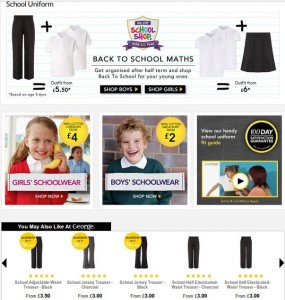
These prices are far from invented. Asda’s George (prices quoted above) probably seizes the record, but M&S closely follws suit (Polo’s starting at £3, trousers from £6, shirts from £8, some items from £1.50). It goes without saying that Tesco and Sainsbury’s play in the same league.
Think that is too good to be true? It probably is …
Never thought about further? Then this article is for you.
Thought about it, but never quite figured how to do better? Then this article is food for thought for you.
What do we know about how these uniform items can possibly sold at such a ‘competitive’ – for not to say insane, and actually impossible – price?
- In 2008, Wal-Mart – Asda, and therefore George’s US based parent company – was found out to source school uniforms from JMS Garments Factory in Chittagong, Bangladesh. As it happens JMS habitually had workers do 19-hour shifts to finish Wal-Mart’s orders under tight deadlines; they were made to stand for hours as punishment for arriving late to work; and were frequently subject to verbal abuse and kicking or beatings. Some workers earn as little as $20 each month, which was even lower than the country’s legal minimum wage of then $24 per month (which was not a living wage at the time either).
- We also know that the worker behind the garment will have received somewhere in the range of 1% to max 5% of the garment’s retail price. We know that retailers such as Asda or M&S tack on a markup of between 2 and 2.8 to what the garment was valued at after landing (and including duties, transport etc.)
- We also know that the by far largest material value of the garment lies in the fabric it is made of (sic!).
- We further know that some of the cheapest cotton comes out of Usbekistan, a country that until recently knew compulsory child labour during harvest season, and that now knows compulsory slave labour of the entire adult population, and particularly of teachers, doctors and nurses.
In short – it can be said with fair certainty that hardly anyone along the line made any reasonable money out of these uniforms (with exception of the retailer, that is); and that the social and environmental conditions hidden in the manufacturing chain are probably the material of nightmares, and fodder for campaigns such as Greenpeace’s Detox or the Clean Clothes Campaign ‘Let’s clean up fashion‘.
Frankly, as someone highly interested in corporate strategy I never quite understand who can really make such bad ethical decisions that will back fire eventually. Greed so far still goes a long way it seems. But I’m being carried off.
But what to do, and in particularly ‘how to do better’? Without breaking the bank that is? There are a few interesting, and down right practical, things happening around this topic of which parents, schools – and not the least the kids themselves – should be aware of.
Unfortunately though, most of these initiatives are confined to the UK, at least to my knowledge. I’d hence appreciate hints to any other resources in other countries that know mostly compulsory school uniforms.
So here we go:
- Marks & Spencer has got a dedicated range of certified Fairtrade cotton (rich) schoolwear.
- The Fairtrade Foundation has published a leaflet to Fairtrade Cotton School Uniforms. The leaflet includes a considerable list of names and contact details of uniform suppliers for schools. The items they offer cover the whole range: from cotton school bags to socks, via shirts, t-shirts, trousers etc.
- Global Footprints published a Model Ethical SchoolUniform Policy for schools. The policy can be easily adapted (and translated) to any other country than the UK.
- The UK knows the Schoolwear Association, who represents “we represent all those involved in the supply of school specific uniform including retailers, direct to school suppliers, manufacturers, distributors, wholesalers, suppliers, decorators, agents and schools”. Much about their work is on awareness raising and helping UK uniform manufacturers remain in business. Not the last by trying to pressure govenment to have schools contract the school uniforms from a UK supplier.
- In the London borough of Tower Hamlet, and interest group has formed the “Tower Hamlet Ethical School Uniform Campaign”, which aims at raising awareness among parents and school about the working conditions most of the dirt cheap school uniform garments are made. The campaign leaflet not only lists all the most important (and ugly) facts, but also shows how parents and schools concretely can take action.
- The Ethical Consumer has published some time ago (in 2008) the “Free shopping guide to School Uniforms” which rated and evaluated the companies and brands then available in the UK. A few of them have gone out of business since (notably No.1 rates ‘Clean Slate’), but with Adam’s Kids schoolwear, the National Schoolwear Centre’s own brand, and Mothercare scoring among the best 5 also (at a time when M&S was still lagging substantially behind), it is clear that there is a reasonably good ‘better’ offer for school uniforms out there.
- Finally, the Australian Fair Wear foundation has a dedicated website specifically for schoolwear. On the website, they detail what actions each interested party (school board, students, parents, teachers) can take to change the current status quo. The concent is in reality applicable internationally.
Importantly, they offer templates for Procurement policies and School Uniform policies, letters to authorities and manufacuterers etc. that are practical material to implement the required changes practically.

